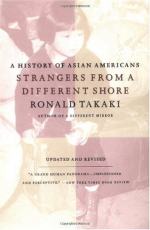
|
| Name: _________________________ | Period: ___________________ |
This test consists of 15 multiple choice questions and 5 short answer questions.
Multiple Choice Questions
1. When did the Filipinos begin to migrate?
(a) 1910.
(b) 1905.
(c) 1945.
(d) 1837.
2. In 1940, what percent of Chinese immigrants lived on the West coast?
(a) 12%.
(b) 57%.
(c) 92%.
(d) 49%.
3. Why did the second generation of Koreans differ from the first generation?
(a) They did not speak Korean.
(b) They were educated.
(c) They wanted to return to Korea.
(d) They were Americanized.
4. What war resulted in a more diverse America?
(a) WWI.
(b) WWII.
(c) The Gulf War.
(d) The Cold War.
5. Unlike their counterparts in Hawaii, what did Filipinos in other states face?
(a) Fair wages.
(b) Equality.
(c) Unions.
(d) Racial discrimination.
6. What did Lung On and Ing Hay do when they arrived in America?
(a) Started farming.
(b) Became doctors.
(c) Went to college.
(d) Opened businesses.
7. What illegal papers caused someone to be called a "paper son."
(a) Birth certificate.
(b) Death certificate.
(c) Immunizations.
(d) Citizenship papers.
8. Why were Asian-Indians able to find jobs in the fields down South?
(a) They were willing to do hard work.
(b) Low wages.
(c) The ban on Chinese immigrants.
(d) There were a lot of positions available.
9. In what year did Hawaiians recruit Asian-Indian workers?
(a) 1902.
(b) 1943.
(c) 1825.
(d) 1865.
10. After the earthquake of 1906, who was allowed to enter the country?
(a) Indian women.
(b) Chinese men.
(c) Chinese women.
(d) Japenese women.
11. After the war, what did workers gain the right to?
(a) Unions.
(b) Collective bargaining.
(c) Strikes.
(d) Vacation time.
12. What was the name of the organization laundromat owners formed?
(a) Chinese Landromat Alliance.
(b) Asian American Workers Union.
(c) Chinese Laundry Alliance.
(d) Chinese Hand Laundry Alliance.
13. What percentage of immigrants live in areas sparsely populated with Asians?
(a) 5%
(b) 90%.
(c) 41%.
(d) 12%
14. When did Lung On and Ing Hay come to America?
(a) 1920s.
(b) 1950s.
(c) 1880s.
(d) 1900s.
15. Who became the largest ethnic voting block in Hawaii after the war?
(a) Hispanics.
(b) The Koreans.
(c) The Japanese.
(d) The Asian-Indians.
Short Answer Questions
1. How does Takaki described the majority of Chinese immigrants in his book?
2. What did Koreans have to compete with other Asians for?
3. What were the wages like in the agricultural industry?
4. What did many Filipinos try to be?
5. What percentage of Korean immigrants have college degrees?
|
This section contains 334 words (approx. 2 pages at 300 words per page) |

|




